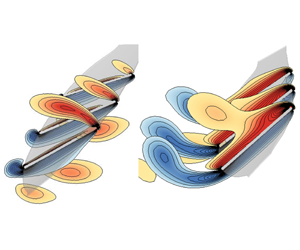Article contents
Aerodynamic-force production mechanisms in hovering mosquitoes
Published online by Cambridge University Press: 08 July 2020
Abstract

For many insects in hovering flight, the stroke amplitude is relatively large (above  $120^{\circ }$) and the lift is mainly produced by the leading-edge vortex (LEV) attaching to the wing (the delayed-stall mechanism). Mosquitoes have a very small stroke amplitude (
$120^{\circ }$) and the lift is mainly produced by the leading-edge vortex (LEV) attaching to the wing (the delayed-stall mechanism). Mosquitoes have a very small stroke amplitude ( ${\approx}45^{\circ }$) and the LEV does not have enough time to form before a stroke ends; thus, the delayed-stall mechanism can not be used. In the present study, we show that their lift is produced by different aerodynamic mechanisms from those of insects with a large stroke amplitude: in a downstroke and upstroke, two large lift peaks and a relatively small one are generated. The first large lift peak (at the beginning of the stroke) mainly comes from the added-mass force caused by the large acceleration of the wing. The second large lift peak (in the mid-portion of the stroke) is produced by the ‘fast-pitching-up rotation’ mechanism: the wing fast pitches up while moving forward, generating a large-magnitude, opposite-sign vorticity at the trailing edge of the wing and near the leading edge of the wing; the rapid generation of opposite-sign vorticity at different locations of the wing results in a large time rate of change in the first moment of vorticity, hence a large aerodynamic force. The third lift peak, which is near the end of the stroke and is small, is a result of the fast-pitching-up rotation of a rapidly decelerating wing. Note that although the added-mass force contributes positive lift in the beginning part of the stroke when the wing is in acceleration, it gives negative lift in the next part of the stroke when the wing is in deceleration; i.e. the added-mass force has no effect on the time-average lift, but it greatly changes the time distribution of the lift.
${\approx}45^{\circ }$) and the LEV does not have enough time to form before a stroke ends; thus, the delayed-stall mechanism can not be used. In the present study, we show that their lift is produced by different aerodynamic mechanisms from those of insects with a large stroke amplitude: in a downstroke and upstroke, two large lift peaks and a relatively small one are generated. The first large lift peak (at the beginning of the stroke) mainly comes from the added-mass force caused by the large acceleration of the wing. The second large lift peak (in the mid-portion of the stroke) is produced by the ‘fast-pitching-up rotation’ mechanism: the wing fast pitches up while moving forward, generating a large-magnitude, opposite-sign vorticity at the trailing edge of the wing and near the leading edge of the wing; the rapid generation of opposite-sign vorticity at different locations of the wing results in a large time rate of change in the first moment of vorticity, hence a large aerodynamic force. The third lift peak, which is near the end of the stroke and is small, is a result of the fast-pitching-up rotation of a rapidly decelerating wing. Note that although the added-mass force contributes positive lift in the beginning part of the stroke when the wing is in acceleration, it gives negative lift in the next part of the stroke when the wing is in deceleration; i.e. the added-mass force has no effect on the time-average lift, but it greatly changes the time distribution of the lift.
- Type
- JFM Papers
- Information
- Copyright
- © The Author(s), 2020. Published by Cambridge University Press
References
Liu et al. supplementary movie 1
Hover flight of M1. The left part of the movie shows the flight captured by the top-view camera; the middle and right parts of the movie show the flight captured by the two horizontal-view cameras, respectively. Playback speed is 10fps, approximately 0.2% of the actual speed of the movie.
Liu et al. supplementary movie 2
Hover flight of M5. The left part of the movie shows the flight captured by the top-view camera; the middle and right parts of the movie show the flight captured by the two horizontal-view cameras, respectively. Playback speed is 10fps, approximately 0.2% of the actual speed of the movie.
- 32
- Cited by


